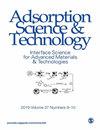Impregnation of Silver Nanoparticles onto Polymers Based on Sugarcane Bagasse for the Remediation of Endocrine Disruptor–Bisphenol A from Water
IF 2.8
4区 工程技术
Q2 CHEMISTRY, APPLIED
引用次数: 4
Abstract
This present study introduces a contemporary innovation of synthesized polymer–silver nanoparticle nanocomposite adsorbent based on sugarcane bagasse (AgNP-SB-βCD) for the sequestration of emerging micropollutant–bisphenol A from water matrix. Batch adsorption mode was carried out to assess the effectiveness of AgNP-SB-βCD nanocomposites towards eliminating bisphenol A (BPA). Characterization techniques including SEM, FTIR, and XRD have confirmed the successful incorporation of silver nanoparticles (AgNPs) onto bagasse–polymer. At 25°C, pH 7, and contact time of 120 min, the nanocomposites had a maximum uptake capacity of 158.4 mg g-1on BPA. The equilibrium isotherm of BPA on AgNPs-SB-βCD has fitted effectively with Langmuir model while the adsorption kinetics conformed to pseudo-second order. The adsorption phenomenon was controlled mainly by physisorption (via host–guest inclusion van der Waals bonding and pore filling effect). In addition, oxidative degradation of BPA by AgNPs-SB-βCD could marginally contribute the removal of BPA due to oxidative dissolution of AgNPs at pH 7. The thermodynamic results substantiate the spontaneity and exothermic behaviors of the adsorption phenomenon. The polymeric nanocomposite adsorbent was regenerated five times (using 75% ethanol) without considerable loss of its adsorption capacity. This authenticates its reusability and consistency performances; accordingly, it can be a market competitor adsorbent for the treatment of water contaminated with BPA.纳米银在甘蔗渣基聚合物上的浸渍对水中内分泌干扰因子双酚A的修复作用
本研究介绍了一种基于甘蔗渣合成的聚合物-银纳米颗粒纳米复合吸附剂(AgNP SB-βCD)的当代创新,用于从水基质中螯合新出现的微污染物-双酚a。采用分批吸附法评价了AgNP-SB-βCD纳米复合材料对双酚A(BPA)的去除效果。包括SEM、FTIR和XRD在内的表征技术已经证实了银纳米颗粒(AgNPs)成功地结合到甘蔗渣-聚合物上。25°C时,pH 7,接触时间120 分钟,纳米复合材料的最大吸收能力为158.4 毫克 g-1在BPA上。BPA在AgNPs SB-βCD上的平衡等温线符合Langmuir模型,吸附动力学符合拟二阶。吸附现象主要由物理吸附(通过主客体包合范德华键合和孔隙填充效应)控制。此外,由于AgNPs在pH下的氧化溶解,AgNPs SB-βCD对BPA的氧化降解可能对BPA的去除起到一定作用 7.热力学结果证实了吸附现象的自发和放热行为。聚合物纳米复合吸附剂再生五次(使用75%乙醇),吸附能力没有显著损失。这验证了其可重用性和一致性性能;因此,它可以成为市场竞争对手的吸附剂,用于处理被BPA污染的水。
本文章由计算机程序翻译,如有差异,请以英文原文为准。
求助全文
约1分钟内获得全文
求助全文
来源期刊

Adsorption Science & Technology
工程技术-工程:化工
CiteScore
5.00
自引率
10.30%
发文量
181
审稿时长
4.5 months
期刊介绍:
Adsorption Science & Technology is a peer-reviewed, open access journal devoted to studies of adsorption and desorption phenomena, which publishes original research papers and critical review articles, with occasional special issues relating to particular topics and symposia.
 求助内容:
求助内容: 应助结果提醒方式:
应助结果提醒方式:


